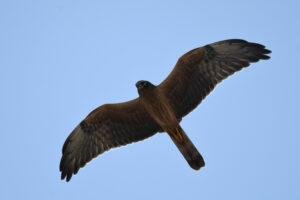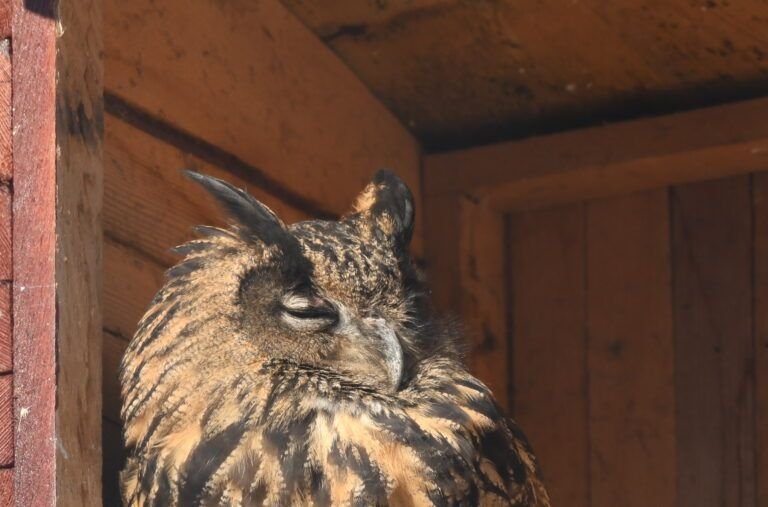The Montagu’s harrier (Circus pygargus) is a migratory bird of prey of the harrier family. Its common name commemorates the British naturalist George Montagu. The genus name is derived from the Ancient Greek. Circus is from kirkos, referring to a bird of prey named for its circling flight (kirkos, « circle »), probably the hen harrier, and pygargus is Modern Latin derived from Greek pugargos, from puge, »rump » and argos, « shining white ». The species name was formerly used for the hen harrier before Montagu’s was identified as a different species.
Sexual dimorphism is particularly apparent in the plumage of this species. Adult males are characterized by their overall pale grey plumage contrasting with black wingtips. Compared with other harriers this species has characteristic black bands along the secondaries, both above and below the wing and rusty streaks on belly and flanks. Adult females have a broadly similar plumage to that of pallid and hen harriers. The underparts are mostly pale yellow-brown, the belly with longitudinal stripes and the wing coverts spotted. The upper parts are uniform dark brown except for the white upper tail coverts (« rump »), and the sightly paler central wing coverts.
The juvenile plumage resembles that of the female, but differs by the belly and under wing coverts which are not spotted, but uniformly red brown in colour.
A melanistic form occurs regularly in this species. In this form the male is much darker than usual, with a black head, brownish black above and grey underparts. The melanistic female is entirely chocolate brown except for grey flight feathers. Partially melanistic morphs can also be found.
Flight
The Montagu’s harrier has a particularly graceful flight, with powerful and elegant wingbeats which give an impression of buoyancy and ease. In true harrier fashion it searches the countryside, flying low, and generally holds its wings with a marked positive dihedral.
The Montagu’s harrier is a deceptively small raptor, though it appears larger because of its large wing surface compared to small body weight, which gives it a typically buoyant flight. The female is larger than the male because the female needs to produce eggs, however this is not apparent in the field.
- Wingspan: 97–115 cm (38–45 in)
- Length: 43–47 cm (17–19 in) (tail: 16–18 cm (6.3–7.1 in))
- Weight(average):
- Male: 265 g (9.3 oz)
- Female: 345 g (12.2 oz)
- Risk of confusion
Habitat
This species can be found in a middle-latitude band of predominantly temperate climates, but also in Mediterranean, and boreal zones. Although it has been found nesting up to 1,500 m (4,900 ft), it is essentially a lowland species, and nests mostly in broad river valleys, plains, and levels bordering lakes and the sea. It can breed in wetlands, though these are often smaller and dryer than those used by the marsh harrier. It also utilizes heaths, dunes, moors, and can be found in the steppe. It adapts to shrublands in gorse or heather and to areas planted with young conifers.
When no other suitable habitat is available this harrier will nest in agricultural farmlands where it is vulnerable to early harvesting. Amongst these it chooses especially grasslands and cereal crops such as wheat, barley, oats and colza. In western Europe, up to 70% of the population breeds in artificial habitats.
In short, for breeding the Montagu’s harrier requires a large open area, with sufficiently tall ground vegetation to afford cover without being overgrown. It favours posts on which both male and female can rest and survey the breeding area: these can be fenceposts, small trees, or rocky outcrops. When hunting, in any season, it prefers areas of low or sparse vegetation where prey is more visible. Densely settled areas are generally avoided and it is highly susceptible to disturbance.
Food and foraging methods
The diet consists mainly of small rodents, small birds, bird eggs, reptiles (including snakes) and large insects (mainly Orthoptera, which are numerically the most common).
As this bird has a wide distribution, it will take whatever prey is available in the area where it nests; in the northern range it will mainly take ground squirrels and rabbits, whereas in southern Europe, it mostly takes small reptiles and large insects. In areas where the food supply is composed almost exclusively of rodents, the breeding success depends greatly on the cyclic fluctuations of vole populations.
Status and distribution
This species can still be found throughout most of the Western Palearctic. In most European countries there is at least a small population, except in Norway where it is not present. The breeding range extends as far east as the Urals, whereas the most western population is that of Portugal. Breeding also occurs in northern Africa, mostly in Morocco. In Great Britain, the species is limited to southern England. In Ireland the species is rarely seen, and mainly in the South, although there are a number of breeding records, the most recent from 1971. Despite having a wide distribution, this bird is not common in many areas and has strong populations only in France, Spain, Russia, Belarus and Poland where the greater part of the European population can be found. Breeding sites frequently change, with some sporadic nesting occurring outside known breeding areas, however clear signs of reduced range are apparent and are associated with population decline.
Status in Britain
Montagu’s harrier is a rare breeding bird in Britain. There are two breeding areas – the area surrounding The Wash, and downland areas of southern England, from Dorset and Hampshire north to Oxfordshire. Away from these areas it occurs only as a scarce migrant. One site, Estuary Farm, near North Wootton in west Norfolk, a special observation area was negotiated with local landowners, so that pressure could be taken off other nesting pairs. In 2005, a pair bred on the Holkham estate. In 2015, it was reported that some Montagu’s harrier were nesting at Blacktoft Sands, Humberside.
Population trends
The population for the western Palearctic is estimated at 35,000–50,000 pairs. The global population is unknown and could be anything between 150,000 and 200,000 individuals(Birdlife International, 2004). This uncertainty is due to the fact that most of the world’s population is situated in Russia and former Soviet republics where it is not quantified.
The males may be polygamous, then having to feed two females and later two broods, either simultaneously or consecutively.
The Montagu’s harrier is a long distance migrant. Birds from Eurasia spend the winter in sub-Saharan Africa, while those from the eastern part of the range migrate to the Indian subcontinent. In Europe, the first birds start to move at the beginning of August and most have left by mid-October. They travel over a broad front, crossing the Mediterranean at various points, and only a small number are observed at migration choke points. Western birds don’t go further south than the gulf of Guinea, but some eastern birds travel as far as South Africa. In Africa, their diet is composed mostly of insects and birds, and it is possible that they follow locust swarms.
Spring return peaks in April, and most birds have arrived by May though there is evidence that first-year juveniles spend their first summer in the winter quarters.




